
Barbados
Most visitors travel to Barbados for its famous beaches and warm, tropical weather. These features are truly world-class, but there is so much more to discover and enjoy on this unique island. Although no longer a colony, the visitor will notice the flavor of the bygone empire in the surroundings and the culture, with a great deal of modernity mixed in, inspired by the tourist trade. You will want to explore the whole island to really appreciate all that Barbados has to offer.


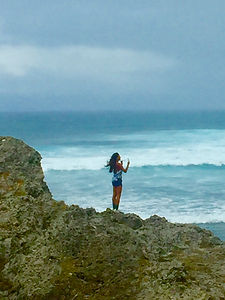


Background
Barbados is a pear-shaped island in the Lesser Antilles archipelago, close to South America. It is comparable in size, geographically, to the city of San Diego. Unlike most of the other islands in this island chain, it is not volcanic but instead was formed by another type of geologic process - uplift - over a long period of time. It is composed almost completely of ancient coral reefs which grew around the edges of the uplifted rock, forming terraces as the rock was lifted higher and higher.
This island is very young, emerging from the sea only about 700,000 years ago. Many of the older buildings are built from coral blocks and unpaved roads from crushed coral, contributing to the visual charm of the historic habitations.
In the 1600’s the island was claimed by England, which established plantations to grow sugar cane, a crop that involved slave labor due to the very labor-intensive cultivating and harvesting methods. Thanks to the excellent topography, climate, and soil, the production of cane in Barbados was spectacularly successful and the island became the central commercial point in the British Empire for sugar and rum. Vestiges of this bygone life can be found all across the island.
The island is divided into 11 “parishes” each of which, remarkably for such a small blob of land, have a distinct character. The airport is on the south coast in Christ Church parish. Bridgetown, the capital and main city, is in Saint Michael on the southwest corner of the island.
How to book:
-
Barbados has been a tourist destination for a long time, and tourism is a major part of the economy, so booking your entire trip online is easy. For your best holiday, you will want to research the locations of the activities you want to include in your time there and then find lodging in a location that provides good access. I find the south coast is a good launching point.
Seasonal differences:
-
In winter there will be more tourists, fleeing from winter weather in the northern hemisphere - US, Canada, and Europe. Consequently, prices are higher, traffic is busier, and reservations harder to get. The locals say the water is “too cold” for them, but compared to water temps back home, you will probably not agree.
-
In the spring (before June) and autumn (after October), traffic lightens up a bit especially closer to the summer months, and prices transition to the “off-season” - more reasonable rates.
-
The summer is the least busy time and prices are best, but this is hurricane season and those storms come up without a lot of forewarning.
Currency:
-
The Barbados Dollar is tied to the American Dollar and perpetually worth $2 BD to $1 USD. Easy, when shopping just divide in half. Credit, and also American money, is accepted almost everywhere so it is not necessary to change money before you arrive, although you will receive BD in change when you use your American bills.
Climate:
-
The climate is tropical, changing little from winter to summer - hot and humid all year round. The length of day versus night changes little as well, with an average of 12 hours of day and 12 hours of night year round. The trade winds consistently blow from the east and rain is a common occurrence.
-
The eastern shore is always windward and a nice breeze can be counted on to cool off with. There you will find the serious waves and jagged shoreline. Swimming in these waters is not for the casual bather.
-
The western shore is calm and leeward. Many pleasure-seeking tourists will only ever see the west side of the island where lounging on the beach and soaking in the warm azure water is undeterred by wind and waves. On this coast you will find the beach life as well as expensive hotels, resorts, restaurants, golf courses, and other luxury and pleasure-oriented activities. Unfortunately this quintessential tropical paradise is a Mecca for crowds so the west coast is consequently noisy, and traffic can be dense and frustrating.
-
The south coast is a hybrid with beautiful beaches that sport more interesting water action but not crazy, pounding waves - for those who like body boards. Snorkeling is also popular here.
-
The north coast of this pear-shaped island is really just a point and is what you might call “far flung” - a day-long expedition given the indirect road system - although there is some beautiful scenery (spectacular waves smashing against rock cliffs) and a few tourist spots, such as the anemone cave.
Language:
-
Bajans (shorthand for Barbadians) speak “Caribbean” which is essentially English, although American and European English speakers will find it indecipherable. Be sure to listen closely and when replying speak carefully if you want yourself to be heard. It is not necessary to shout, though.
Transportation:
-
The island is a patchwork of roads. In olden days, plantation folk did not need to travel far and did their crop inspections and churchgoing and neighborly visits by horse and carriage. Roads were primarily intended to connect neighboring plantation houses or traverse around their perimeters. Consequently, there are no direct routes across the island. An exception to this rule can be found in the new roads that connect the airport with the major west coast towns, again inspired by the tourist trade. If you wish to travel anywhere else you will need to be patient and may end up doing some backtracking if you missed a left turn or right turn (this is especially true in the highlands). Finger signs can be found at crossroads and are helpful but not foolproof. Have your route mapped out before you hit the road.
-
Public transportation, in the form of buses, does connect most places on the island where locals need to frequent. Visitors on a budget can take the bus to most places you want to visit, but if your itinerary includes exploration of off-the-beaten-track destinations the bus system may not suffice.
-
Automobiles are available to rent and offer greater freedom of the “open road” and a more efficient use of vacation time. Most vehicles on this island are of the small variety. If your party exceeds 3 adults (with luggage), a van is your best option. Booking ahead of your trip is highly advisable. Pre-hired rental cars can be picked up at the airport after a great deal of paperwork.
-
Gasoline is sold by the liter and is very expensive so plan your trips efficiently and fill up your tank ahead of a busy day of driving - gas stations are not as plentiful in some parts of the island as one might hope for.
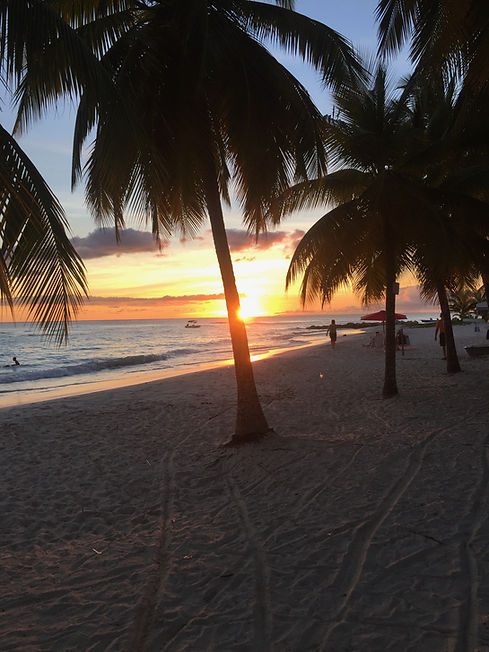
Recommendations
To help you make decisions about your trip
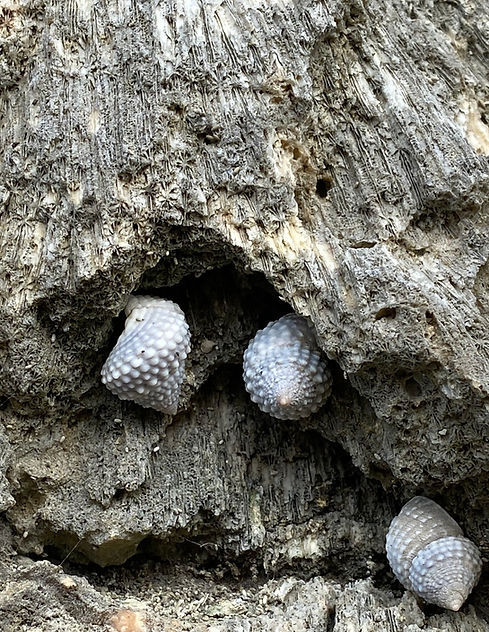
Features
Beaches
Barbados has some of the worlds most beautiful, pristine, white, shiny beaches because they are built from ground-up coral. Sometimes tinted pink with seashells. Lying on the beach or walking along at low tide is a marvelous feeling. Some of the beaches in more populated areas will have chaise and umbrella vendors to make your all-day lounging more comfortable.
You will be accosted by rum punch, coconut water, jewelry, and beach accessory vendors as you dream the day away on your chaise. Pocket beaches away from the crowds can be found in less populated areas - you can sometimes have the beach to yourself! The water is delightfully warm and swimming (or lolling about in the gentle surf) can be where you spend most of your beach day.

Chattel House. Photo Credit: My Guide Barbados
History
The history of occupation of this island goes way back - there are some extant structures that are several hundred years old. The coral block plantation houses, sugar factories, and windmills are part of the charm and history of this place and many former plantations are now museums, allowing visitors to glimpse island life in the days of the great houses.
There are also vestiges of habitations that were occupied by the slave populations, and the history of suffering, rebellion, and freedom is told as well.
Rum Punch is a Barbados original concoction and can be acquired anywhere, including on the beach.
To make your own, follow this recipe:
1 Cup Sour (lime juice)
2 Cups Sweet (Falernum or simple syrup)
3 Cups Strong (rum)
4 Cups Weak (ice)
shake of bitters
Convert cups to whatever measurement you choose, but keep the proportions.
Sugar and Rum
The sugar and rum industry was the foundation of Barbados’ historic prosperity, up until the time when sugar became too cheap and plentiful from other sources in the 20th century. You will encounter sugar cane fields all around the island. This crop is harvested twice each year. If your visit coincides with the harvest, you can find some cane to snack on - a real treat!
Some rum factories are still in operation, making boutique rums. Tours are offered and there are often product tastings. A visit to an old factory will also be an architectural tour, as the old coral block buildings last forever and are still optimal for such operations.
The gift shops sell other delicacies besides rum, such as confections and other liquors. Touring a rum factory should definitely be on your itinerary.
Barbados has it’s own local beer and this factory offers tours as well.
Tropical
Nothing says “vacation” like palm trees and tropical flowers. You can see these anywhere on the island, but visiting a botanical garden gets you into a lush, naturalistic paradise that is peaceful and beautiful. There are also natural gullies and caves where you can find native as well as imported species. Spending the day in shady groves surrounded by eye candy is a treat you should not miss.
Tribes of monkeys are protected and curated in some of the parks. Visitors can catch views of them en masse at feeding time.
Of course there are colorful and sweet-singing birds that can be found in any tree or bush all around the island.

Water
Sports
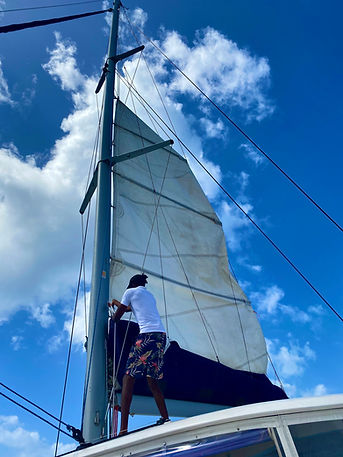
Swimming: Who doesn’t want to loll about in warm, clear water? A local activity that my family has practiced for generations is to swim out just beyond the rough and bob in a circle with friends (like a tea party but without the china) to gossip, trade ideas, and watch the land-based activities from a new perspective. My mother (who grew up in Barbados) said the sea heals whatever ails you. We like to swim with the current from point to point and then walk back along the beach - good exercise.
Board sports: Surfing along the east coast is world class. There is the famous Soup Bowl at Bathsheba for the experienced surfer. Kite surfing is also an east coast activity as the wind is always blowing. Body boarding is popular on the south coast. Quality waves are reliable but can be sometimes fiercer than expected if there’s a storm out at sea. For the experienced types the east coast is exciting, but some beaches tend to slope dramatically at the beach breaks and the waves are known to slam the unsuspecting onto the sand with gusto.
Sailing: It may be difficult to rent a sailboat to captain on your own, but there are certainly lots of opportunities to board a boat with a crew and captain and enjoy the pleasures that accompany the excursion, from catamaran sailing with food and drink to the Jolly Roger party cruise for your pirate experience. Viewing Barbados from the sea is an experience that puts the scale of the island in perspective, if you remain sober enough to see past the edge of the boat.
Snorkling and scuba: Unfortunately, the reefs surrounding the island are mostly dead. Nevertheless there is plenty of colorful fish to view with snorkel gear, congregating around the dead reef structures. Snorkelers can also view green turtles occasionally. These turtles tend to favor certain locales, and the sail tours will take you there (the tour boat operators feed them which is why they can usually be found at these spots).
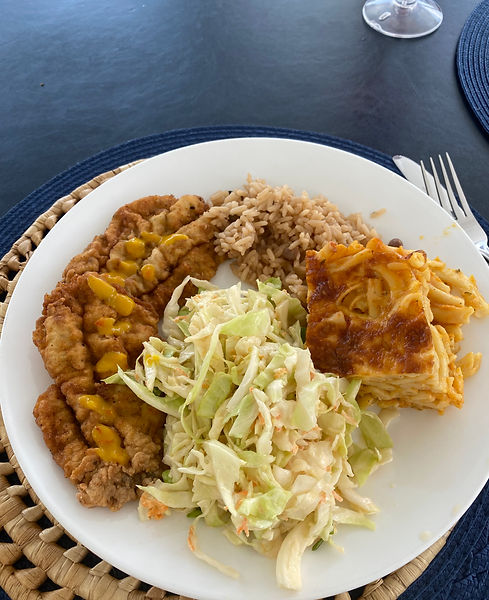
Flying Fish, Peas and Rice, Macaroni Pie, Cole Slaw
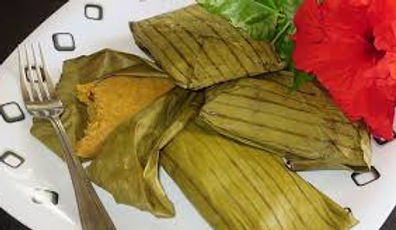
Conkies
Photo credit: Barbados.org
Food
Caribbean delicacies! There are the usual dishes that one would expect, like jerked chicken and rice and beans, but Barbados does have its own specialties.
Pepper pot is a sort of beef stew that can be found simmering on the back burner in most homes. Souse is pickled pork accompanied by steamed sweet potato “pudding.” Conkies are delicious coconutty cornmeal dessert packets steamed in banana leaves. Flying fish are palm sized fillets that are seasoned, breaded, and pan fried and the flavor is mild and sweet, but these fish are seasonal. Cou cou is Caribbean polenta, sometimes made with breadfruit. Pumpkin fritters are little fried pumpkin dumplings. Barbados Macaroni Pie is like no other - with flavor and heat and lots of cheesiness. Barbados Coleslaw has lime and turbinado sugar in addition to other flavors - this is not your unfortunate, gratuitous tourist slaw that accompanies fish and chips states-side!
And so much more…
Coconut vendors are ubiquitous, on the beaches and along the roads. You can purchase a coconut with the top chopped off and a straw inserted, or the water drained out and the coconut filled with rum punch. The coconut vendors along the roadside will sell you coconut water in large containers to take home to your refrigerator.
Sugar cane juice is rare but a must try - it is a dark green, sweet, and grassy coif.
Recommendations Section
Map of parishes and towns - Barbados map
Public transit - Bus system
Features Section










